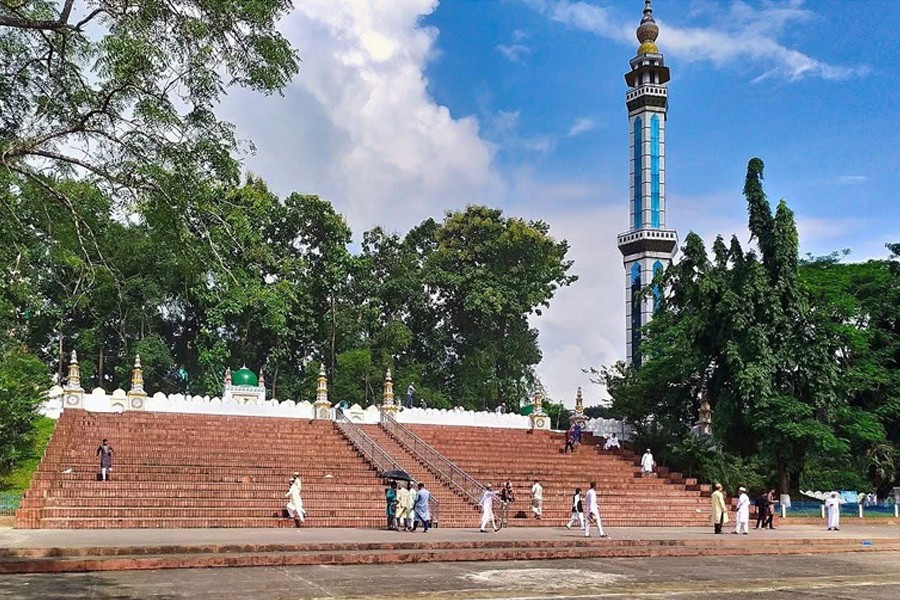
Published :
Updated :

Despite there being a number of historical sites in the country's north-eastern region, the historic Shahi Eidgah in Sylhet city has for ages carried a significant importance to the people for generations.
The Eidgah is located on a hillock surrounded by bewitching natural beauty. A vast habitation has developed gradually around it during the past few decades. The neighbouring areas also have come to be known by the name-Shahi Eidgah.
Located at the eastern corner of the city of great Muslim saint Hazrat Shahjalal (RA), the over 300 years old structures of the Eidgah attract visitors from home and abroad.
However, some parts of the Eidgah have been renovated during the recent years keeping the historic things intact.
Historians say that the renowned Mughal Foujder, Farhad Khan, had built the attractive and eye catching structures of the Eidgah during the late 80s of the eighteenth century.
Farhad Khan was appointed a Foujder for Sylhet region during the 1770s when Aurangazeb was in power in Delhi. Soon after Farhad Khan took over as a Foujder, he started building a number of establishments. Even today, some of these keep him remembered.
In the city's Mirabazar-Shibganj road, there is a small bridge called 'Farhad Khaner Pul'. However, this had also been rebuilt. Farhad Khan had constructed a number of bridges, mosques and roads in Sylhet. He built the Shahi Eidgah, the biggest and the most wonderful Eidgah of Bangladesh, in the late 80s of the 18th century.
To the north of the Eidgah, there are a few forest officers' houses on the green hillock. To the south are some dwelling houses while to the east are a mosque and shrine of the Muslim saint, Hajarat Shahmir. Planned tree plantations are there on the western side of the Eidgah.
On all the four sides, once there were green hillocks, but by now it is albeit changed as people rearranged those for residential purposes, except the north having forest hills.
However, it is quite a normal scene for the Sylhet city, although the face of nature had been changed constantly by men every day.
The attractive Eidgah has three main gates on its three sides, along the roads. Two years ago, these were renovated and reshaped at a cost of Tk3.9 million by a local businessman named Taru Miah and his children.
There are seven more gates of smaller sizes for entering the place of worship. Sylhet Zila Parishad also did some civil works for the construction of the Eidgah maidan and the steps on four sides of the pond located inside the Eidgah.
The pond has been there from the beginning. The Eidgah can accommodate about one lakh people for offering the Eid prayers.
However, more than a lakh Muslims come to this Eidgah every year to say their prayers. A big crowd of devotees spill over the main Eidgah to the adjacent roads and hillocks.
There are 16 high stairs, now covered by red bricks to reach the main floor of the Eidgah which is surrounded by a wall that has fifteen 'Ggumbujes' (Domes).
There was a time when every year on the10th of Muharram, thousands of people used to gather here for joining lathi khela (indigenous sport with sticks) in remembrance of the tragedy of the Muharram. It was an attractive and very important event of the year for the common people of those days.
In the month of Muharram of 1782, two religious leaders, Syed Mohammad Hadi and his brother Syed Mohammad Mahdi along with their followers revolted against the British from this ground.
Robert Lindsay, the then British Collector of Sylhet shot these brothers dead to foil the revolt against the British.
This was even before the great revolt by Titumir. On that fated day in 1782, Syed Hadi and Syed Mahdi along with their followers gathered there with a Muharram procession. They planned to attack the British all on a sudden. But, things went wrong as the collector through his spies got the message ahead of the day. Lindsay reached the field along with a contingent and asked the people to surrender their arms. But the two brothers and the follows declined and revolted.
At one stage of the long fight, Syed Hadi was shot dead by Lindsay. Hadi's brother-Mahdi also embraced martyrdom along with some others after a long fight.
Robert Lindsay, who had served for about 12 years in Sylhet, also narrated the sad incident in his memoirs that he wrote on his return to England.
Veteran politicians like Pakistan's founder Muhammad Ali Jinnah, Moulana Mohammad Ali, Hossain Shahid Sohrawardi, Sher E Bangla and many others from the Sub-Continent had visited the place and addressed a number of political meetings during the pre-partition period.
Furthermore, according to the local people, the great Imam of Kaba Sharif also addressed a gathering here years ago.
The Eidgah has become a place for congregation of huge people for spreading the message of peace and humanity.
forsylhet@gmail.com


 For all latest news, follow The Financial Express Google News channel.
For all latest news, follow The Financial Express Google News channel.